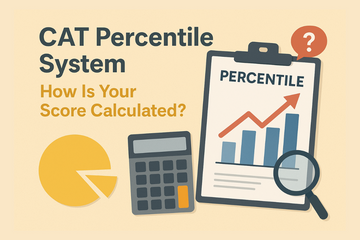Every year, lakhs of aspirants take the Common Admission Test (CAT) in hope of securing admission into prestigious management institutions such as the IIMs, FMS Delhi, SPJIMR, MDI Gurgaon, and other top B-schools in India. While preparing for the exam, students often focus extensively on topics, shortcuts, and mock tests, but when it comes to the CAT percentile system, many remain confused.
- What exactly is a CAT percentile?
- How is it different from the raw score?
- What is a scaled score?
- How do your attempts and accuracy influence your final percentile?
This blog will break down the entire system in simple words, using examples and easy explanations, so that by the end, you’ll have complete clarity on how your performance gets translated into a percentile ranking.
Understanding CAT Basics
Before diving into percentile calculation, let’s understand the CAT exam structure.
Exam Pattern
The CAT exam is divided into three sections:
- VARC (Verbal Ability & Reading Comprehension) – 24 questions
- DILR (Data Interpretation & Logical Reasoning) – 20 questions
- QA (Quantitative Ability) – 22 questions
- Total questions: 66
- Duration: 2 hours (120 minutes)
- Marking scheme: +3 for a correct answer, -1 for an incorrect answer, and 0 for unattempted/non-MCQ questions.
So, the maximum possible raw score is 198 marks (66 × 3).
Raw Score vs. Scaled Score vs. Percentile
1. Raw Score
This is the direct score you obtain based on your correct and incorrect answers.
Example:
- Attempted: 50 questions
- Correct: 40 → 40 × 3 = 120
- Wrong: 10 → 10 × (-1) = -10
- Raw Score = 120 – 10 = 110
2. Scaled Score
Since CAT is conducted in multiple slots, the difficulty of each slot can vary. To ensure fairness, your raw score is adjusted through a process called normalization.
- If your slot was slightly tougher, your scores might be scaled upwards.
- If your slot was easier, your scores might be scaled downwards.
The scaled score ensures that students across different slots are compared on the same level.
3. Percentile
Percentile is not your percentage. Instead, it represents the relative ranking of a candidate compared to others.
If you are in the 99 percentile, it means you have performed better than 99% of the total candidates who appeared for CAT.
The Step-by-Step Percentile Calculation Process
Let’s now break down the exact process IIMs follow to calculate the CAT percentile.
Step 1: Calculate Raw Score
As shown earlier, you get your raw score based on your correct and incorrect answers in each section.
Step 2: Normalization
Since the CAT is conducted in 3 different slots (morning, afternoon, evening), IIMs use statistical normalization to account for variation in difficulty levels.
This normalization process is applied section-wise as well as for the overall score.
(Note: The exact statistical formula is not disclosed by IIMs, but it’s based on the GATE exam normalization method and standard score distribution principles.)
Step 3: Calculate Scaled Score
After normalization, you receive a scaled score for each section and for the overall exam.
Example:
- Your Raw Score in QA = 50 → Normalized to 52
- Your Raw Score in VARC = 45 → Normalized to 44
- Your Raw Score in DILR = 30 → Normalized to 31
Thus, your scaled scores may slightly differ from your raw scores.
Step 4: Ranking Candidates
Candidates are then ranked section-wise and overall based on their scaled scores.
Step 5: Percentile Calculation
The percentile is calculated using the following formula:
Percentile = ((N – R) / N) × 100
Where:
- N = Total number of candidates who appeared for CAT
- R = Your rank based on scaled score
Example:
- Total candidates = 2,00,000
- Your rank = 2,000
Percentile = ((200000 – 2000) / 200000) × 100
= (198000 / 200000) × 100
= 99 percentile
Sectional Percentile vs. Overall Percentile
One key feature of CAT is that you don’t just need a good overall percentile but also a minimum sectional percentile to qualify for IIMs.
- Sectional Percentile → Shows your relative performance in each section (VARC, DILR, QA).
- Overall Percentile → Based on the combined scaled score.
Example:
- VARC Percentile: 95
- DILR Percentile: 99
- QA Percentile: 90
- Overall Percentile: 98
This means while your overall performance is excellent, some IIMs may reject your application if they require a minimum 95 percentile in each section.
Why Normalization Is Important?
Imagine you appeared for Slot 1 and found it extremely difficult, while Slot 3 was much easier. Without normalization:
- A student in Slot 3 might score 120 marks easily.
- A student in Slot 1 with the same skill might score only 100 marks.
Normalization ensures both are compared fairly, adjusting scores so that difficulty differences don’t harm anyone’s chances.
Factors Influencing Your Percentile
- Accuracy – Even a few negative marks can drop your percentile.
- Slot Performance – Normalization will balance difficulty, but consistency matters.
- Competition – More serious candidates mean a tougher percentile game.
- Balanced Sectional Performance – Neglecting one section can cost you IIM calls.
Percentile vs. Marks Trend
Over the years, CAT results show that even a small difference in marks can create a big jump in percentile.
Here’s an approximate trend (for overall percentiles):
|
Percentile |
Scaled Score (Range) |
Approx. Correct Attempts |
|
99.9 |
155–160 |
50–52 correct |
|
99 |
105–110 |
36–38 correct |
|
95 |
80–85 |
28–30 correct |
|
90 |
70–72 |
24–25 correct |
|
80 |
50–55 |
18–20 correct |
|
70 |
40–45 |
14–15 correct |
(Note: These are approximate values and vary by year depending on difficulty level.)
Common Misconceptions about CAT Percentile
- Percentile is not the same as percentage – Scoring 99 percentile does not mean 99% marks; it means you’re ahead of 99% of test-takers.
- High attempts ≠ High percentile – Accuracy matters more than blind attempts.
- Equal importance of all sections – Even if you score very high overall, low performance in one section can block your IIM chances.
- Normalization doesn’t give advantage to any slot – It only ensures fairness.
Strategy to Improve Your Percentile
- Focus on Sectional Balance – Don’t ignore VARC or DILR while chasing QA or vice versa.
- Accuracy Over Attempts – Aim for 80–85% accuracy; wild guessing reduces percentile.
- Mock Test Analysis – Understand your strengths, weakness, and scoring patterns.
- Target Strength First, Then Weakness – Secure easy marks, then gradually improve weak sections.
- Time Management – Practice sectional time allocation since each section is 40 minutes non-switchable.
Final Thoughts
The CAT percentile system is designed to ensure fairness, accuracy, and relative ranking among lakhs of aspirants. While raw scores show your performance, normalization and percentiles reveal your true standing among competitors.
Understanding this system helps you set realistic score targets. For example:
- To aim for IIM Ahmedabad or Bangalore, you generally need 99+ percentile.
- For newer IIMs or good private B-schools, a 90–95 percentile is often sufficient.
So instead of stressing about “how many marks = 99 percentile,” focus on consistent accuracy, balanced preparation across sections, and mock test analysis. With the right strategy, you can crack the percentile game and secure your dream B-school admission.








gam9vw
gz8rfc
1qxtdx
erutv1